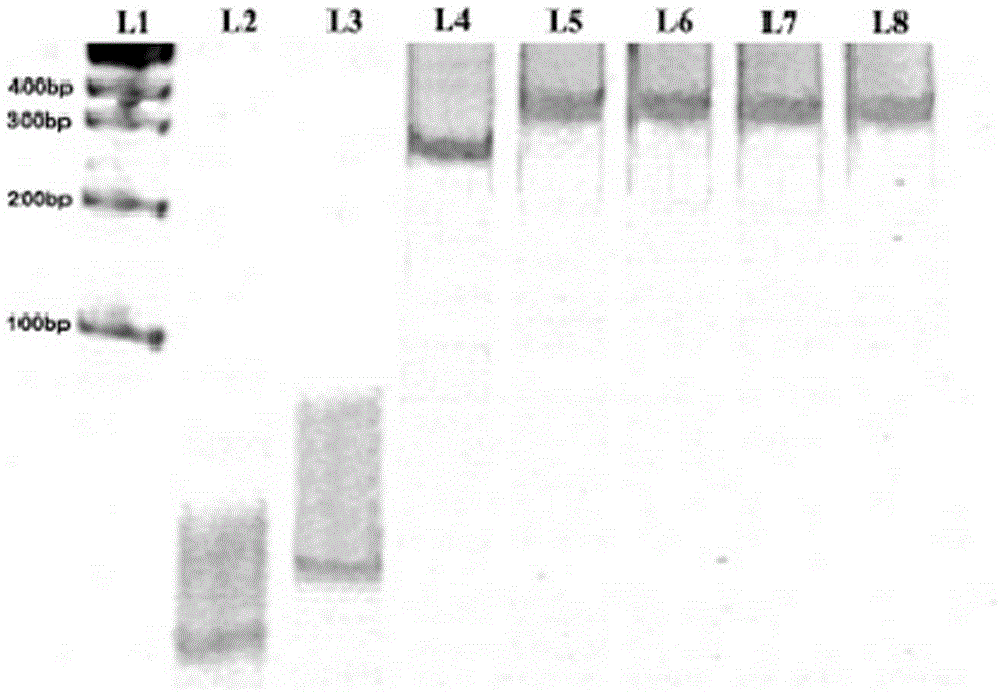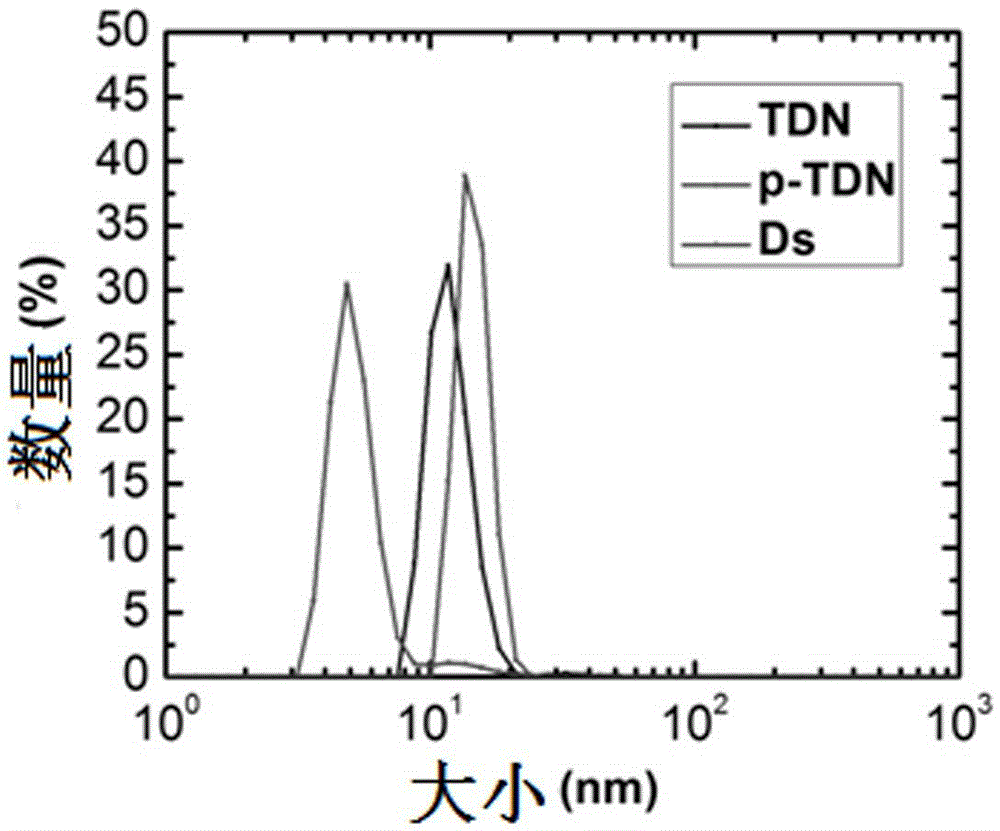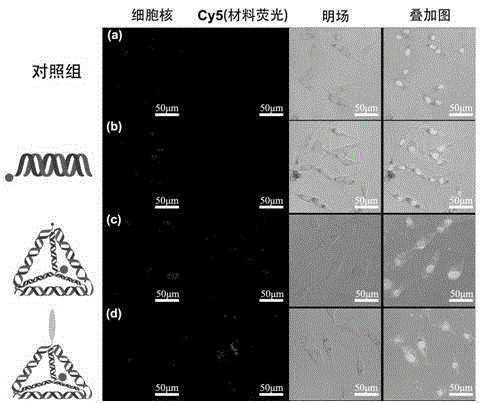Targeted DNA nano-probe and preparation and application thereof
A nano-probe and targeting technology, applied in the direction of DNA preparation, recombinant DNA technology, DNA / RNA fragments, etc., can solve the problems of poor tissue compatibility and metabolic difficulties, and achieve the effect of avoiding damage and good biocompatibility
- Summary
- Abstract
- Description
- Claims
- Application Information
AI Technical Summary
Problems solved by technology
Method used
Image
Examples
Embodiment 1
[0030] Step 1: Take 2 μL of single-stranded DNA (50 μM) TDN-1, TDN-2, Cy5-TDN-3, N 3 - TDN-4 added to 42 μL Tris-MgCl 2 (Tris10mM, MgCl 2 50mM, pH8) solution. The mixed solution was placed in a PCR instrument at a reaction temperature of 95° C., cooled rapidly to 4° C. after 10 minutes, and continued to react for 30 minutes. A single strand of DNA can self-assemble into a three-dimensional DNA tetrahedral configuration through complementary base pairing.
[0031] Step 2: Take 180 μL of PBS solution (pH 7.3), 40 μL of CuSO 4 Aqueous solution (0.1mM), 40μL of TCEP aqueous solution (0.1mM) and 40μL of TBTA solution (10μM, dissolved in DMSO) were prepared as a reaction solution. Take 100 μL of the prepared TDN solution (2 μM) and 200 μL of the target peptide solution (2 μM) whose amino acid sequence is RGERPPR, and add them to the above reaction solution. After shaking at 37°C for 5 hours at a constant temperature of 175 rpm, the reaction is complete.
[0032] Step 3: Add the...
Embodiment 2
[0034] Step 1: Take 2 μL of single-stranded DNA (50 μM) TDN-1, TDN-2, Cy5-TDN-3, N 3 - TDN-4 added to 42 μL Tris-MgCl 2 (Tris10mM, MgCl 2 50mM, pH8) solution. The mixed solution was placed in a PCR instrument at a reaction temperature of 95° C., cooled rapidly to 4° C. after 10 minutes, and continued to react for 30 minutes. A single strand of DNA can self-assemble into a three-dimensional DNA tetrahedral configuration through complementary base pairing.
[0035] Step 2: Take 180 μL of PBS solution (pH 7.3), 40 μL of CuSO 4 Aqueous solution (0.1mM), 40μL of TCEP aqueous solution (0.1mM) and 40μL of TBTA solution (10μM, dissolved in DMSO) were prepared as a reaction solution. Take 100 μL of the prepared TDN solution (2 μM) and 200 μL of the target peptide solution (2 μM) whose amino acid sequence is RPAKPAR, and add it to the above reaction solution. After shaking at 37°C for 5 hours at a constant temperature of 175 rpm, the reaction is complete.
[0036]Step 3: Add the ab...
Embodiment 3
[0038] Step 1: Take 2 μL single-stranded DNA (50 μM) Cy5-TDN-3, N 3 -Comp.-TDN-3 (complementary chain of TDN-3 chain) added to 46μL Tris-MgCl (Tris10mM, MgCl 2 50mM, pH8) solution. The mixed solution was placed in a PCR instrument at a reaction temperature of 95° C., cooled rapidly to 4° C. after 10 minutes, and continued to react for 30 minutes. DNA single strands can self-assemble into DNA double strands through complementary base pairing.
[0039] Step 2: Take 180 μL of PBS solution (pH 7.3), 40 μL of CuSO 4 Aqueous solution (0.1mM), 40μL of TCEP aqueous solution (0.1mM) and 40μL of TBTA solution (10μM, dissolved in DMSO) were prepared as a reaction solution. Take 100 μL of the prepared TDN solution (2 μM) and 200 μL of the target peptide solution (2 μM) whose amino acid sequence is RGERPPR, and add them to the above reaction solution. After shaking at 37°C for 5 hours at a constant temperature of 175 rpm, the reaction is complete.
[0040] Step 3: Add the above reactio...
PUM
 Login to View More
Login to View More Abstract
Description
Claims
Application Information
 Login to View More
Login to View More - R&D
- Intellectual Property
- Life Sciences
- Materials
- Tech Scout
- Unparalleled Data Quality
- Higher Quality Content
- 60% Fewer Hallucinations
Browse by: Latest US Patents, China's latest patents, Technical Efficacy Thesaurus, Application Domain, Technology Topic, Popular Technical Reports.
© 2025 PatSnap. All rights reserved.Legal|Privacy policy|Modern Slavery Act Transparency Statement|Sitemap|About US| Contact US: help@patsnap.com



